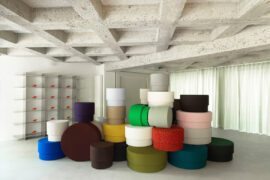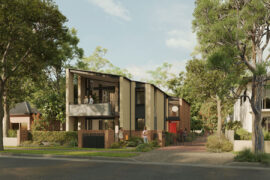If the LANDMARK by Lexus pavilion has previously been about electrifying the senses, more recently Lexus Australia stepped out of the fast lane with a highly curated, slowed-down approach.

January 15th, 2024
It was all part of the pavilion’s theme this year – close to the source – which played out in a variety of ways, starting with Koichi Takada Architects.
Takada returned this year with perhaps an even richer, lush exterior response to Joost Bakker’s original pavilion structure, dressing its three levels in cascading greenery draped over multiple split-level awnings, featuring a rich display of Japanese and Australian native landscapes.

Terraced like rice fields, the curved awnings softened the angular lines of the base building, echoing the greenery of Flemington Racecourse’s front strait and creating an impressive statement as the first pavilion upon entry to the Birdcage Enclosure.
Inside, each level reflected three distinct experiences – Source, Cultivate and Harvest – with six key collaborators expressing the theme through their work: chef Luke Mangan, mixologist Priscilla Leong, florist Katie Marx, ceramicist Sam Gordon, coffee makers St Remio, and furniture duo Laker, by Henry Wilson and David Caon.

For Henry Wilson at Studio Henry Wilson, it was his second time in the pavilion. His iconic wall sconces were backlit beautifully in the dining room and within the stair.
But it was his first appearance under the experimental furniture brand he co-directs with fellow designer David Caon at Caon Design Office.
“Laker is an explorative design business,” Wilson says. “It’s the kind of space where we effectively join our minds and resources on projects we don’t have the capacity for in our practices but are fun things we want to work on together.”
Related: Koichi Takada on the 2023 Pavilion

Their work was showcased at the rear of the dining room area comprising two large eight-seater dining tables and ‘Alpine’ chairs to match.
The chairs are a ‘naïve’ riff on traditional workshop chairs of the Tyrolean region in Austria, which Laker first designed in 2021 only making and selling them in Sydney in limited numbers to interested people.
“There’s four stick legs and a seat pad that’s timber and then a backrest that crudely sticks into the back of the seat,” Wilson says.

For LANDMARK at Lexus, the duo designed and made each of the solid American walnut chairs locally in Melbourne, and then began to look around to create a table or two to accompany them.
“We came up with this idea of using componentry, and how we would have our materials come together – that’s fascinating in its own right,” he says.
Again, they found their components and three core materials in Melbourne, with the tables comprising a timber top, acrylic cylinder and a polished aluminium base, connected by one visible central fixing.

Beyond their use in the pavilion, the furniture was designed to be returned and put into other Laker projects, rather than being stored away for future years.
“It’s nice to be able to put high-quality pieces in the pavilion. That’s great for us in terms of general sustainability, because we’ve made them as actual production pieces,” Wilson says.
Complemented by Katie Marx’s ethereal floral arrangements, including purple-dyed rope strung from upended tulip posies and bees buzzing amongst garden beds on the deck, the pavilion created many unexpected – and delightfully sunny – moments from floor to roof.
Koichi Takada Architects
koichitakada.com
Photography
Tom Blachford, Magner Media


We think you might also like this report on a previous LANDMARK by Lexus pavilion.
INDESIGN is on instagram
Follow @indesignlive
A searchable and comprehensive guide for specifying leading products and their suppliers
Keep up to date with the latest and greatest from our industry BFF's!

Gaggenau’s understated appliance fuses a carefully calibrated aesthetic of deliberate subtraction with an intuitive dynamism of culinary fluidity, unveiling a delightfully unrestricted spectrum of high-performing creativity.

How can design empower the individual in a workplace transforming from a place to an activity? Here, Design Director Joel Sampson reveals how prioritising human needs – including agency, privacy, pause and connection – and leveraging responsive spatial solutions like the Herman Miller Bay Work Pod is key to crafting engaging and radically inclusive hybrid environments.

The Sub-Zero and Wolf Kitchen Design Contest is officially open. And the long-running competition offers Australian architects, designers and builders the chance to gain global recognition for the most technically resolved, performance-led kitchen projects.

It’s widely accepted that nature – the original, most accomplished design blueprint – cannot be improved upon. But the exclusive Crypton Leather range proves that it can undoubtedly be enhanced, augmented and extended, signalling a new era of limitless organic materiality.

Take a whirlwind tour of some of the standout appearances at 3daysofdesign 2025.

Featuring designs by Studio Johnston, Sam Crawford Architects, SAHA and others, the NSW Pattern Book for low-rise homes is a milestone in housing design.
The internet never sleeps! Here's the stuff you might have missed

After 23 successful years operating jointly as Kvadrat Maharam, Kvadrat and Maharam will continue as independent entities from 1 July 2025.

Simple Design Archive is inspirational architecture that is designed for people and place, with serenity at its heart.